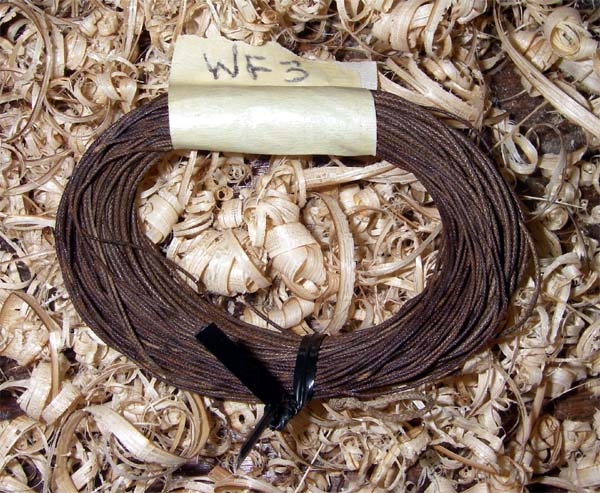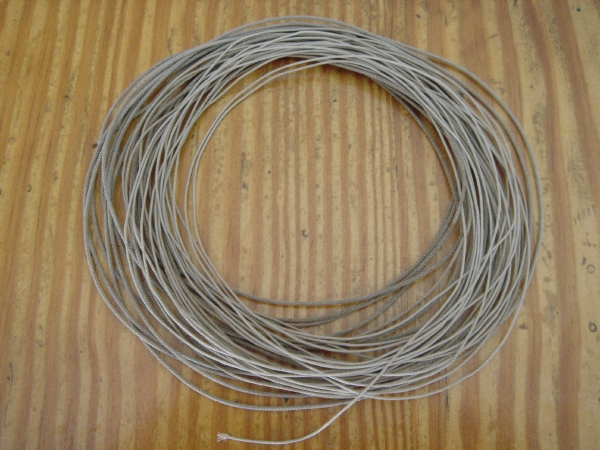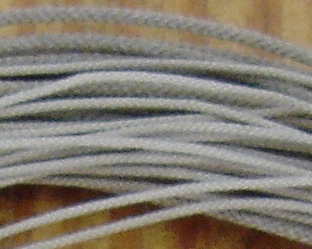http://grassart.net/forum/viewtopic.php?t=11
I’ve done it.
They cast beautifully.
You can refinish an old line like this.
3-weight Silk Fly line in need of refinishing (image care of
Matt Schliske)
Cleaning a Silk Fly Line
Using Reed Curry’s Recipe as a basis for reconditioning an old silk fly line, I used the instructions as a method for my own way and came up with excellent results so far.

CLIK for a movie
I’ve invented a way to make a “washing machine” for the lines that will evenly wash the line and force the solution into the line with very little effort. You can use a glass Mason Jar with a lid (poke a single hole to release fizz and gas) to fill with solution and shake the line up just like your clothes washing machine. This will also keep the mess to a minimum while minimizing wasted materials.




List of things you will need:
1ea Large Mason Jar and lid (with single small hole punched in middle of lid)
2 ea containers (Rubbermaid bin with towel in bottom of both) or paper bags will do.
4ea white wash cloths or towels (two for table, two for bins or bags) or paper towels.
Arm & Hammer baking soda
Woolite liquid laundry soap
Warm or running water
#1 a) Take a large mason jar and label the lid what line you will recondition in the jar, use masking tape for the label (the label follows the line if you have multiple to re-finish)
b) Poke a single hole in the lid, take the line and coile it in the jar, take Arm & Hammer baking soda and dish a couple of heaping tablespoons in, add warm water half way up, screw lid on, aggitate or jigger shake it vigorously holding you finger over the single hole but releasing built up gas. The solution will go from cloudy clear/white to brown and or a tinge of what ever the line color is along.
c) Empty jar leaving line inside.
#2. a) Take the garden hose (or kitchen sink faucet) and place the flow of water in the jar and rinse liberally. Then fill half way up with water, add lid and shake. The water might be slightly cloudy.
b) Empty jar of water, leave line in jar.
#3 Repeat step #1 and #2 again and again (as necessary) until water is crystal clear.
#4 a) Take the line out and measure just a little Woolite into the Mason Jar, fill half way with water and then add in line. Do not place Woolite directly onto line, make the Woolite and water solution first and then place the line into that solution.
b) “Wash” the line in this solution by agitating the jar with the lid on, don’t forget to hold your finger over the hole.
c) Rinse, rinse rinse until no bubbles or foam is in the jar. Take the line out of the jar and rinse the line in your hand liberally to remove all traces of Arm & Hammer, old finish and Woolite.
d) Repeat rinsing until the line is completely clear of bubbles and foam.
Silk line after stripping with above method on a 3-weight WF
Detail of line after stripping with above method on a 3-weight WF
#5 a) Take two clean white dry wash cloths and place line on one on the table and pat dry. With the wad of line on the table and cloth, locate one end and start un-tangling into the Rubbermaid bin with towel in bottom or paper bag with paper towel in bottom what ever you choice. Keep loosening and pulling line through itself.
b) Be careful and do not pull quickly in order not to wear line against itself. You will get to the point where you will find that it is now easier to start untangling the other end into the other bag or bin.
c) When you are finishied with the detangle, place the line in loose loops in one of the bins. Take the pat dry wash cloth and run the line through it pinching line but not letting heat build up. Do this a couple of times. There should be very little residue in the cloth. Make loose coils to dry on the white wash cloth or in a clean dry shoe box.
d) Let line completely air dry. This may take a day or more in a humid climate. It is dry here in Arizona and it takes at least 12 hours.
Refinishing a Silk Fly Line
Now that your line is completely stripped down to the raw silk, you will want to refinish the line with boiled linseed oil and condition it with Red Tin Mucilin.
First, gather your materials.
1 quart jar
a few sheets of newspaper
paper towels for clean up
soft cloth, an old t-shirt works well
1 quart of boiled linseed oil (some use Formbys Tung Oil Finish)
turpentine
[under construction]
Yeahooo!
Very stoked, awesome…
To finish, I use straight boiled linseed.
Soak, lay out on aluminum foil to dry, might take two weeks between coats. I coat it at least 3 or more times.
Buff out with your fingers.
Apply Red Tin Muclin as usual.
DO NOT apply Muclin after fishing, dry the line first, only apply Muclin on a dry line.
Along with silk lines, you need a line dryer and patience. If the line is going to be on the reel more than months without being used, store it in loose coils or on your dryer in a dry environment.
Storing and or application of Muclin on a silk line that is wet and or soaked will rot the line rendering it ruined.







